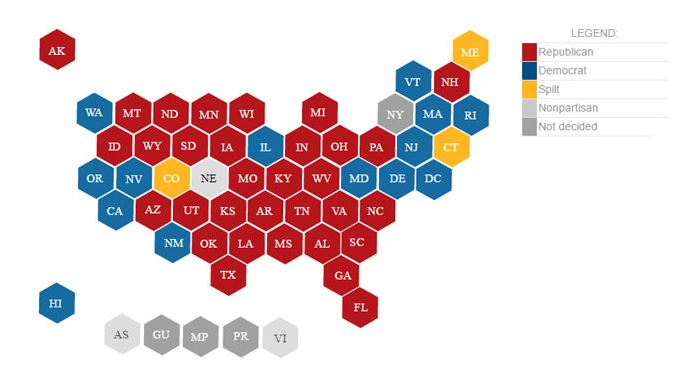Democrats Got Wrecked Again in State Legislative Races, and it Matters More Than You Might Think
The GOP has Donald Trump, a congressional majority, the majority of governorships, and full control of 33 state legislatures.
Just a little over two years after they used their control of the state House, state Senate, and governor's mansion to pass a bevy of progressive policies—one of the nation's highest minimum wages, tighter gun laws, and huge spending on rural broadband internet, to name a few—Democrats will be the minority party in both chambers of the Minnesota legislature next year.
They are the latest victims in a four-cycle-long electoral tidal wave that has flooded state legislatures with Republicans and cost Democrats nearly 1,000 seats, leaving them able to dictate policy in only a handful of states. Helped along by some friendly redistricting and a national backlash against the federal government, Republicans will continue to set the policy agenda in the majority of states, have a crucial backstop to protect their congressional majority, and are potentially one more successful cycle away from being able to exercise the ultimate power in U.S. politics: amending the Constitution.
In Minnesota, Republicans erased a 38-28 Democratic majority in a single election and will enter the 2017 session with a one-seat majority in the state Senate (they flipped the state House in the 2014 midterms). Aside from Donald Trump's shocking win in the presidential race, the outcome in Minnesota might have been the biggest surprise of election night, but it fits within a national trend. Democrats are struggling to hold legislative majorities, even in typically blue-ish states like Minnesota.
In red or purple states? Forget about it.
In Pennsylvania, where the legislative chambers historically have swung back-and-forth between the two major parties, Republicans have made gains in four consecutive cycles and now have the largest state House majority since 1958 (depending on how you're counting, it might be the largest since the 1940s when the legislature had fewer seats) and have a nearly veto-proof edge in the state Senate too.
The story is the same across the map. Republicans now control both legislative chambers in 32 states, up from 30 before last week's election. As recently as 2010, Republicans controlled as few as 14 states.

In addition to the Minnesota Senate, Republicans also won control of the Iowa Senate and the Kentucky House, giving them majorities in both chambers in those two states as well. It wasn't all bad news for Democrats, though, as they did flip the New Mexico House and both chambers in Nevada to their side.
A widely shared (but inaccurate) tweet from Marc Porter McGee, a Virginia-based education advocate, suggested that Republicans are just a single legislative chamber away from being able to amend the U.S. Constitution without any input from Democrats.
That's not true because amendments to the U.S. Constitution must be approved by a two-thirds vote in both chambers of Congress and Republicans don't have a super majority in either. Amendments must also be approved by three quarters of the states (38 out of 50), per Article V of the Constitution.
After this year's election, Republicans control both chambers in 32 states—it's actually 33 if you count Nebraska, which has a single legislative chamber and is technically non-partisan (but really isn't)—while Democrats control both chambers in 13 states and one chamber in four others. In order to amend the Constitution without Democratic votes, Republicans would have to flip at least six more legislative chambers (the four currently held by Democrats in states with split-party control and two more Democrat-controlled chambers in one of those other 13 states).
Still, after seeing what's happened in Minnesota in the last two years, it's not impossible to imagine that happening by 2018 or 2020. The fact that we're even discussing this possibility gives you a sense of how badly routed Democrats have been at the state level in recent years.
Perhaps more important than discussions about amending the Constitution is the fact that Republicans are likely to control the vast majority of state legislatures at the end of the decade. That would give them the ability to influence the redistricting process after the next Census. As I wrote last week, the wave of GOP victories at the state legislative level in 2010 is directly linked to Republican's virtually unassailable majority in the U.S. House. Even though redistricting is handled differently in different states, state lawmakers usually have at least some control over the process—and in some places they get to literally draw the congressional district maps with little oversight from the executive or judicial branches.
That means that If Democrats have any hope of winning full control of Congress before 2030, they have to start by reversing the trend of GOP victories in legislative races.
Realizing as much, President Barack Obama in October called for Democrats to put more of an emphasis on winning those sometimes-overlooked races. He personally endorsed more than 150 candidates in legislative races from coast-to-coast, but it doesn't appear to have made much of a difference.


Show Comments (131)